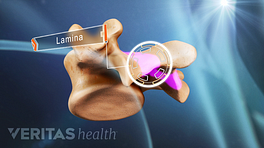Many people find that surgery provides effective relief from their painful sciatica symptoms. The type of surgery that is recommended can vary considerably and will depend on the underlying cause of sciatica. Having surgery for sciatica is typically elective, which means it is the patient's decision whether or not to have surgery.1
If non-surgical treatment does not provide relief for your sciatica symptoms, your physician may suggest surgery as an option. See Sciatica Surgery
Here are potential reasons why surgery may be recommended for treating sciatica, as well as insights on why the same type of surgery may not be right for everyone.
Do I need surgery for my sciatica symptoms?
Surgery may be required when sciatica is caused by serious underlying conditions, such as cauda equina syndrome, tumors, infections, or severe lumbar disc herniation. Surgical treatment of these conditions helps preserve leg function and improves the quality of life.
In other cases, surgery may be an option to consider, such as when:
- Leg and/or foot pain is severe and accompanied by progressive neurological symptoms, such as weakness and/or numbness
- Different combinations of nonsurgical treatment options have been tried, including physical therapy, oral medications, and injections
- Leg functionality is significantly limited—for example, performing daily household activities and/or occupation-related activities is considerably impaired
Unless treating a medical emergency, surgery is typically considered after 6 to 8 weeks of nonsurgical treatments are tried.2
See When Sciatica Pain Is a Medical Emergency
What surgical options do I have for treating sciatica?
Several lower back conditions can cause sciatica, with many corresponding types of surgeries. For example, a pinched nerve root may be treated in several different ways depending on the location and causes of the impingement.
Common surgical procedures for sciatica include:
- Microdiscectomy. In this surgery, a small part of the disc material (with or without the adjacent bone) is taken out to relieve nerve root compression.
- Lumbar decompression. Pressure on nerve roots may be relieved by:
- Laminectomy. Part or all of the lamina (posterior part of the vertebra) is removed in order to provide more room for the spinal nerves.
- Foraminotomy. The neuroforamina (bony openings for spinal nerves) are enlarged by trimming the overgrown bone, providing more space for the nerve roots as they exit the spinal canal.
Surgery for sciatica is usually minimally invasive and done with small incisions. In severe nerve compression with multiple causes, open procedures that use larger surgical incisions may be performed, such as an open lumbar laminectomy (open decompression).
What’s the typical long-term outlook after sciatica surgery?
While surgery can provide immediate pain relief from sciatica, research indicates that after a 1- to 2-year period, both nonsurgical and surgical treatments may provide similar results.3,4
In addition to the type and severity of the underlying cause, the outcome of a surgical procedure also depends on other factors, such as age, smoking, and previous history of sciatica.5 It is important to note that sciatica surgery typically aims to improve pain and function in the leg. Localized lower back pain may not improve after a sciatica surgery.3
See Is Surgery the Quickest Path to Sciatica Relief?
If you are considering surgery for your sciatica symptoms, your doctor can help understand the available options and possible outcomes. A doctor can also provide guidance on the appropriate timing for surgery and if nonsurgical options need to be considered beforehand.
Learn more:
Myths About Sciatica Treatment Options
References
- 1.Arts MP, Peul WC; Leiden-Hague Spine Intervention Prognostic Study Group. Timing and minimal access surgery for sciatica: a summary of two randomized trials. Acta Neurochir (Wien). 2011;153(5):967–974. doi:10.1007/s00701-011-0983-8
- 2.Jacobs WC, van Tulder M, Arts M, et al. Surgery versus conservative management of sciatica due to a lumbar herniated disc: a systematic review. Eur Spine J. 2011;20(4):513–522. doi:10.1007/s00586-010-1603-7
- 3.Kumar, M. Epidemiology, pathophysiology and symptomatic treatment of sciatica: A review. nt. J. Pharm. Bio. Arch. 2011, 2. Gugliotta M, da Costa BR, Dabis E, et al. Surgical versus conservative treatment for lumbar disc herniation: a prospective cohort study. BMJ Open. 2016;6(12):e012938. Published 2016 Dec 21. doi:10.1136/bmjopen-2016-012938
- 4.Gugliotta M, da Costa BR, Dabis E, et al. Surgical versus conservative treatment for lumbar disc herniation: a prospective cohort study. BMJ Open. 2016;6(12):e012938. Published 2016 Dec 21. doi:10.1136/bmjopen-2016-012938
- 5.Machado GC, Witzleb AJ, Fritsch C, Maher CG, Ferreira PH, Ferreira ML. Patients with sciatica still experience pain and disability 5 years after surgery: A systematic review with meta-analysis of cohort studies. European Journal of Pain. 2016;20(10):1700-1709. doi:10.1002/ejp.893







